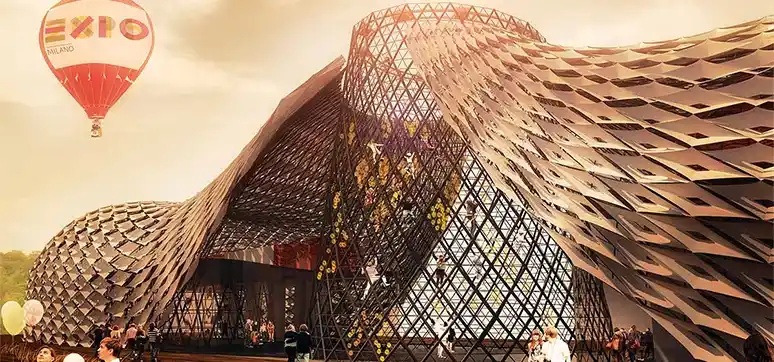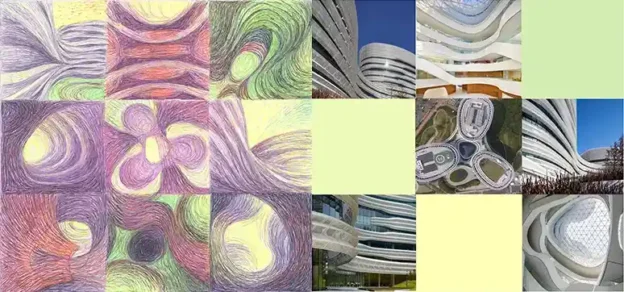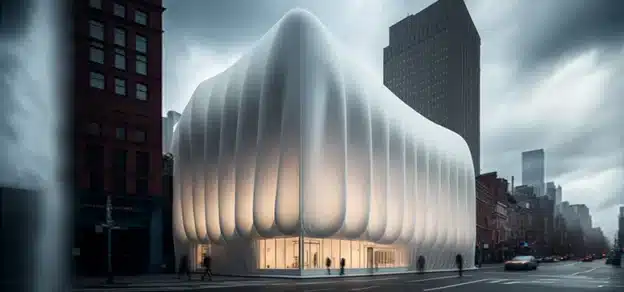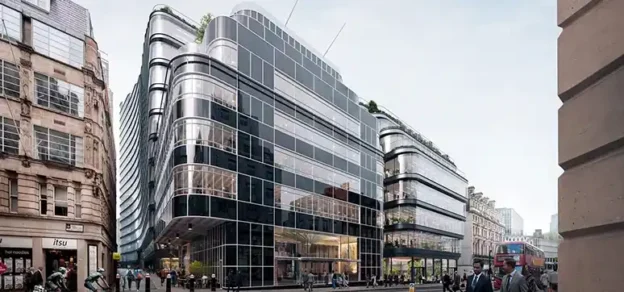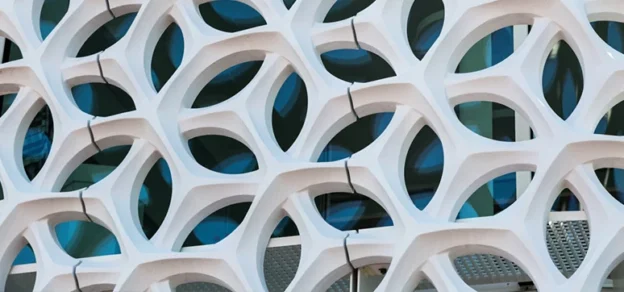Have you ever wondered how trees grow into harmonious proportions and structural equilibrium, how a cactus grows in the desert even after the scarcity of water or how birds construct their structurally stable and beautiful hanging nests? Answers to all these questions are hidden in nature. Nature has divine secrets pertaining to its biological and natural processes which follow some algorithmic rules that secretly pre-exists in this universe. Nature has always inspired mankind through these whimsical secrets. In history, many humans took advantages of these natural secrets to inspire themselves to solve human problems.
Earliest examples include Greek philosophers who studied design of organisms to attain balance and proportion in classical art and Leonardo da Vinci who was inspired by flying birds to invent flying machines. This imitation of nature eventually got recognised by scientists and the term ‘Biomimicry’ was coined in 1982.

In 1997, Janine Benyus made biomimicry popular through her book ‘Biomimicry: Innovation Inspired by Nature’. Following this, Janine Benyus and Bryony Schwan cofounded the Biomimicry Institute in 2005 and defined biomimicry as a novel discipline involving studies pertaining to nature’s best ideas and then exploring them to design and solve human problems.
Biomimicry was explored in architecture even before the term was coined and it was used to solve architectural design challenges by emulating natural and biological processes of nature.

Some early architectural examples that investigated biomimicry include building of crystal palace in 1851 by Joseph Paxton who imitated biological structure of large water lilies for lightweight structural design of this building, Eiffel tower which is structurally inspired by studies pertaining to load bearing process of a human thighbone, and East gate centre in Harare which was designed after studying natural ventilation process inside a termite mound to make a building free of air conditioning.

Eventually, these architectural interventions of biomimicry tickled down into designing facades for the buildings too. Facades are a vital component of our built environment. It is an envelope that interacts with outer environmental conditions to protect inner habitable spaces within the building. Therefore, biomimicry provided an opportunity to design facades in an informed fashion by using these ideas to minimise energy utilisation of a building conspicuously.
According to a research on integrated facades by K H Kim and Alberto Torres from the University of North Carolina at Charlotte, biological processes from nature, such as photosynthesis, hydrophobic effect and photocatalysis inspired the design of photovoltaic façade, self cleansing façade, and pollutant removal facades, respectively.

With the advent of computational design and its tools in architecture, systems based on natural algorithms became feasible to be replicated for design solutions. Computational design of facades involves modelling conceptual façade elements and their assembly system into digital environments with predefined parameters that follow an algorithm or formula. Architects and designers achieve this by using visual scripting tools such as Grasshopper 3D and dynamo. These computational tools allow to follow a parametric design approach for generating various design options.
These design iterations are generated by altering pre-defined parameters to achieve an optimum solution based on design goals. Eventually, these solutions are evaluated for their performance in contextual, environmental and climatic conditions of the site where façade needs to perform for its building inhabitants. Thus, the computational approach results in an informed façade system that responds to the energy efficiency of a building holistically. Recent examples of facades inspired from biomimicry and conceived with help of computational tools include Beijing National Stadium’s façade inspired by a bird’s nest for lighter structure and façade of esplanade theatre in Singapore which mimicked biological skin structure of a Durian fruit to provide optimised shade and light to the building.
Façade Proposal for UK’S Pavilion Milan Expo 2015
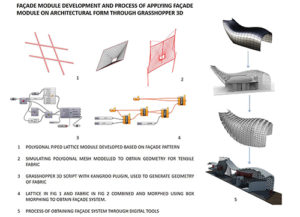
A facade system, proposed by Studio Parametric Curiosity, inspired by biomimicry was developed at University of Nottingham, England for a competition to design UK’s Pavilion for Milan Expo 2015. It was developed in collaboration with Mexican architect Farid Hernandez Eljure and distinguished faculty of architecture department – Dr. John Chilton, Dr. Paolo Beccarelli and Dr. Chantelle Niblock. This project was awarded by Benoy Architects, London for its design and innovation. The pavilion was designed as an interactive space to enhance visitors experience along with a diagrid façade system inspired by anatomy and pollen gathering capability of a pinecone’s moving scales (Fig. 2).
Façade Design Concept and Development
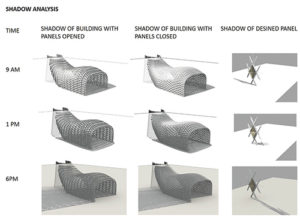
Considering the climate of Milan and design requirements, a biomimetic façade system inspired by pinecone’s responsive ability to its surrounding environment. Pine cone scales sit on an organic diagrid structure and they open and close for air, moisture and pollens. This process was mimicked to conceptualise and develop an efficient façade system for this project. This façade opens or closes to optimise the need for light and ventilation in each space to reduce energy demands.
Fig.3 shows the concept sketch in which central axis of pinecone is thought of as an external skin of pavilion, whereas fabric panels are thought of as the scales of a pine cone. When these fabric panels move forward lighting, shading and ventilation can be altered for the pavilion space. The tensile fabric was chosen to achieve a lightweight structure.
Using computational tools, this design concept was modelled in the physical and digital environment and buildings envelope was populated with these rhombic panels. For this design, Grasshopper 3D was used to script and achieve this design. It provided a swift design option to visualise façade system used for this design (Figs. 4 and 5). Following this façade model development, it was tested for it shadow performance using computer analysis systems to study advantages of this moving façade system. Both shadow patterns were studied for an average hot day in Milan when façade panels were completely open letting in air and light and when they blocked air and light after being closed (Fig.6).
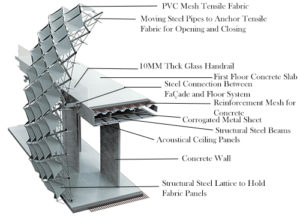
It was found that mimicking pinecone scales and moving these panels based on sun’s movement provided this façade to keep building cooler passively with little air conditioning needed for human comfort as compared to traditional mechanical cooling needs. Finally, a detailed façade assembly was designed for further engineering considerations and a final building design was obtained. (Figs. 7 & 8). Overall, this project was an attempt to design a biomimetic façade system using computational design tools to achieve an efficient performing façade. This manifests the transformations in façade design industry today. In current design realm, architects can explore nature inspired designs swiftly through computational design to test the feasibility of their ideas and solve challenges posed towards them to create efficient façade systems.
Computational design tools cater to limitations that architects used to face while exploring a novel concept related to algorithms and generative design. It is evident how modern technology is changing the pedagogy of design rapidly. As architects, we have a key responsibility to know, learn and integrate such innovative approaches in our architectural design process for a better built environment.
